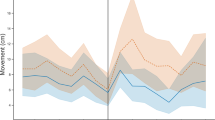Abstract
This study explores the meaning and functional design of a modulatory communication signal, the honey bee shaking signal, by addressing five questions: (I) who shakes, (II) when do they shake, (III) where do they shake, (IV) how do receivers respond to shaking, and (V) what conditions trigger shaking. Several results confirm the work of Schneider (1987) and Schneider et al. (1986a): (I) most shakers were foragers (at least 83%); (II) shaking exhibited a consistent temporal pattern with bees producing the most signals in the morning (0810–1150 hours) just prior to a peak in waggle dancing activity; and (IV) bees moved faster (by 75%) after receiving a shaking signal. However, this study differs from previous work by providing a long-term, temporal, spatial, and vector analysis of individual shaker behavior. (III) Bees producing shaking signals walked and delivered signals in all areas of the hive, but produced the most shaking signals directly above the waggle dance floor. (IV) Bees responded to the signal by changing their direction of movement. Prior to receiving a signal, bees selected from the waggle dance floor moved, on average, towards the hive exit. After receiving a signal, some bees continued moving towards the exit but others moved directly away from the exit. During equivalent observation periods, non-shaken bees exhibited a strong tendency to move towards the hive exit. (V) Renewed foraging activity after food dearth triggered shaking signals, and, the level of shaking is positively correlated with the duration of food dearth. However, shaking signal levels also increased in the morning before foraging had begun and in the late afternoon after foraging had ceased. This spontaneous afternoon peak has not previously been reported. The shaking signal consequently appears to convey the general message “reallocate labor to different activities” with receiver context specifying a more precise meaning. In the context of foraging, the shaking signal appears to activate (and perhaps deactivate) colony foraging preparations. The generally weak response elicited by modulatory signals such as the shaking signal may result from a high receiver response threshold which allows the receiver to integrate multiple sources of information and which thereby increases the probability that receiver actions will be appropriate to colony needs.
Similar content being viewed by others
Author information
Authors and Affiliations
Additional information
Received: 21 March 1997 / Accepted after revision: 30 August 1997
Rights and permissions
About this article
Cite this article
Nieh, J. The honey bee shaking signal: function and design of a modulatory communication signal. Behav Ecol Sociobiol 42, 23–36 (1998). https://doi.org/10.1007/s002650050408
Issue Date:
DOI: https://doi.org/10.1007/s002650050408




